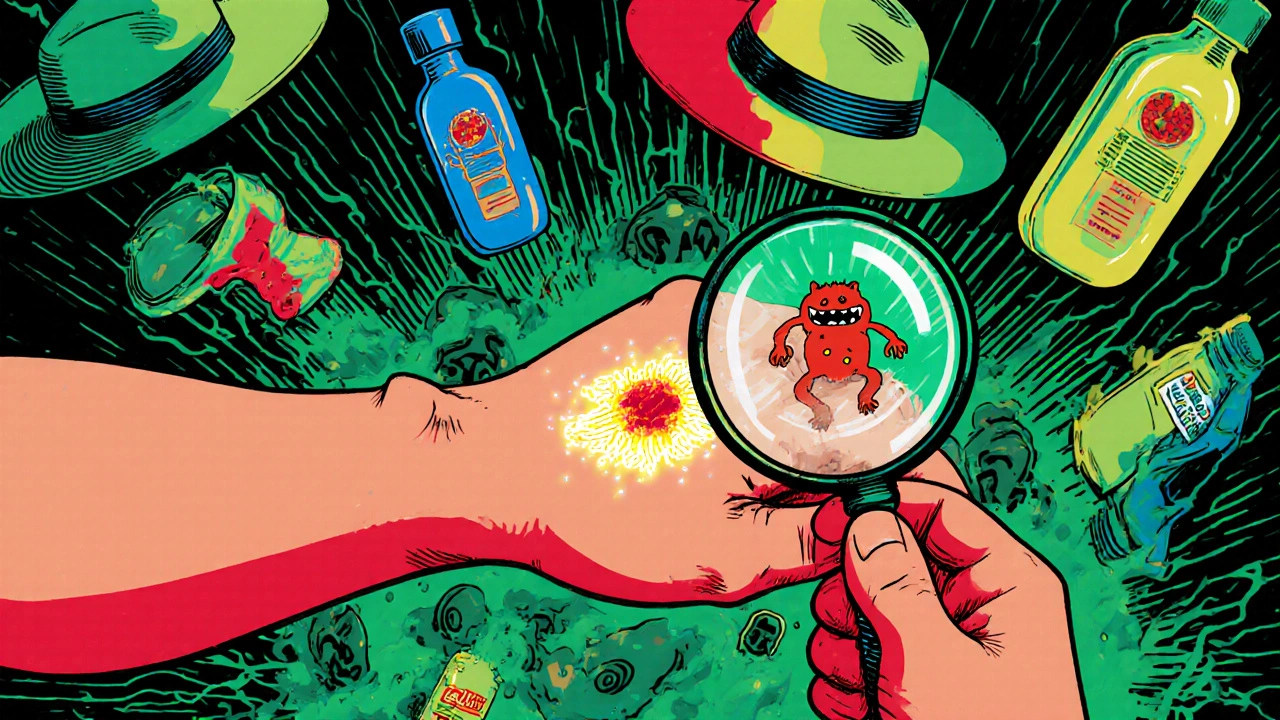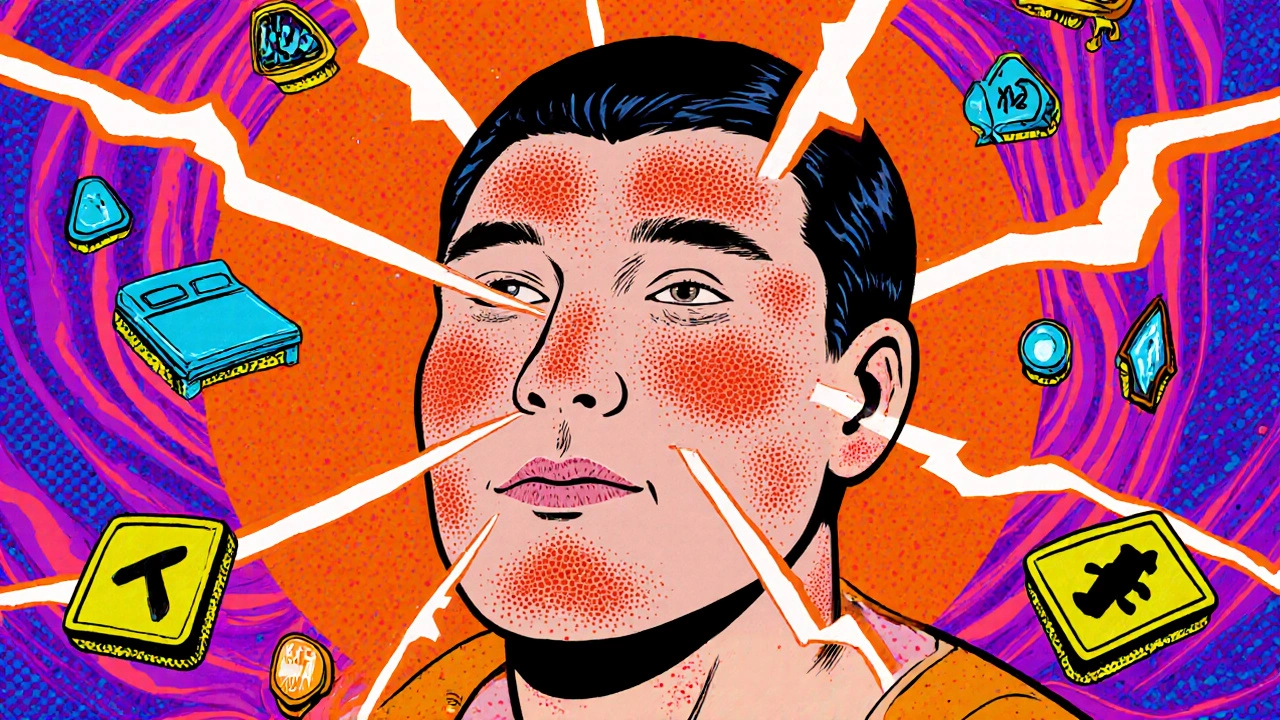More people are walking around with rough, scaly patches on their skin and not even realizing it’s a warning sign. These patches - called actinic keratosis - aren’t just ugly. They’re early signals that your skin has been damaged by too much UV light, and left unchecked, they can turn into squamous cell carcinoma, a type of skin cancer. And the biggest driver behind the rise in these cases? Tanning beds.
What Exactly Is Actinic Keratosis?
Actinic keratosis (AK) looks like a dry, sandpaper-like spot on your skin. It’s usually red, pink, or flesh-colored and feels rough to the touch. You’ll often find it on areas hit hardest by the sun: your face, ears, scalp (if you’re bald), neck, forearms, and the backs of your hands. Some people describe it as a persistent pimple that won’t go away, or a patch that flakes off but comes back.
It’s not just a cosmetic issue. About 10% of untreated actinic keratoses will progress into invasive squamous cell carcinoma over time. That’s not a small risk - it’s a real chance your skin will turn cancerous if you ignore it. And unlike melanoma, which gets all the attention, squamous cell carcinoma is far more common and often starts with AK.
The cause? Cumulative UV exposure. Every time your skin is exposed to ultraviolet radiation - whether from the sun or a tanning bed - your skin cells take damage. Over years, that damage builds up. Your body tries to repair it, but eventually, the DNA mistakes pile up. That’s when abnormal cells form - and that’s actinic keratosis.
Why Tanning Beds Are Making Things Worse
People used to think tanning beds were a "safer" way to get a tan. That’s a myth. The World Health Organization classifies tanning beds as Group 1 carcinogens - the same category as asbestos and cigarette smoke. A single session in a tanning bed before age 35 increases your risk of melanoma by 75%. But the damage doesn’t stop there.
Studies from Australia’s Cancer Council show that people who use tanning beds regularly are 2.5 times more likely to develop actinic keratosis than those who don’t. Why? Because tanning beds don’t just give you a tan - they blast your skin with UVA radiation, sometimes at levels up to 15 times stronger than the midday sun. UVA penetrates deeper than UVB, damaging the skin’s structural layers and suppressing immune responses that normally kill abnormal cells.
And here’s the scary part: most people who use tanning beds start young. Teenagers and young adults think they’re being smart by getting a "base tan" before summer. But that "base tan" is actually skin damage in disguise. Every time you tan, you’re accelerating the buildup of DNA mutations. By the time you’re in your 40s or 50s, those early patches of AK are showing up - and doctors are seeing them more often in patients who used tanning beds in their teens.
Who’s Most at Risk?
Not everyone who uses a tanning bed gets actinic keratosis - but some people are far more vulnerable.
- People with fair skin, light hair, and blue or green eyes
- Those with a history of sunburns, especially during childhood
- Individuals who’ve used tanning beds even once a month for a year or more
- People over 40 - cumulative UV damage takes time to show
- Those with weakened immune systems, like organ transplant recipients
Here’s a hard truth: if you’ve ever used a tanning bed and you’re over 30, you’re in the high-risk group. Even if you only went a few times, the damage is still there. Your skin remembers every exposure.

How Doctors Spot It - And What Happens Next
Most actinic keratoses are found during a routine skin check. Dermatologists don’t need fancy tools - they use a magnifying lamp and a bright light. Sometimes they rub the spot with a gloved finger. If it feels rough like sandpaper, that’s a strong clue.
If there’s any doubt, they’ll do a biopsy - a tiny scrape or cut of the skin sent to a lab. The results confirm whether it’s AK or something worse. Early detection is everything. When caught early, AK is easy to treat.
Treatment options depend on how many lesions you have and where they’re located:
- Topical creams: Fluorouracil (5-FU) or imiquimod applied daily for weeks. They work by killing abnormal cells. Side effects? Redness, peeling, and burning - but it clears the patches.
- Cryotherapy: Liquid nitrogen freezes the spot. It’s quick, cheap, and effective for single lesions. The area blisters and flakes off in a week or two.
- Photodynamic therapy (PDT): A light-sensitive solution is applied, then exposed to a special light. It destroys abnormal cells with precision. Great for larger areas like the scalp or face.
- Chemical peels or laser therapy: Used for stubborn cases or cosmetic improvement.
Most treatments have a 90% success rate when done early. But if you wait, the lesion can thicken, bleed, or turn into cancer. And once it does, surgery becomes necessary - and the risk of spreading increases.
What You Can Do Right Now
If you’ve used tanning beds in the past, don’t panic. But do act. Here’s what to do:
- Check your skin monthly. Look for new rough patches, especially on sun-exposed areas. Take photos with your phone to track changes.
- See a dermatologist yearly. If you’re over 40 or have a history of tanning, get a full-body skin exam. Don’t wait for symptoms.
- Avoid all UV tanning. No more beds. No more sunlamps. No more "getting a tan" for looks. There’s no safe tan.
- Use sunscreen daily. SPF 30 or higher, broad-spectrum, reapplied every two hours if you’re outside. Even on cloudy days.
- Wear protective clothing. Wide-brimmed hats, UV-blocking sunglasses, long sleeves. These aren’t just for beach days - they’re for walking the dog, driving, or sitting outside at lunch.
And if you’ve got a patch that’s been there for months? Don’t ignore it. Don’t try to scrub it off. Don’t cover it with makeup. Get it checked. It’s not just a "bad sunburn." It’s your body screaming for help.

The Bigger Picture
Actinic keratosis isn’t just a skin problem - it’s a public health crisis fueled by misinformation. Tanning salons still advertise "healthy tans" and "anti-aging benefits." But the science is clear: UV radiation ages your skin faster and increases cancer risk at every level.
In Australia, where sun exposure is extreme, the government banned commercial tanning beds in 2015. Since then, rates of skin cancer in young people have started to drop. That’s proof that policy works. But in the U.S. and many other countries, tanning beds are still widely available - and still being marketed to teens.
If you’ve ever used one, you’re not alone. But you’re also not powerless. The damage is done - but you can stop it from getting worse. Catching actinic keratosis early means avoiding surgery, scarring, and cancer. That’s not a luxury. It’s your next best step.
What Happens If You Ignore It?
Ignoring actinic keratosis isn’t just risky - it’s dangerous. Left untreated, these patches don’t just sit there. They grow. They thicken. They change color. Some become hard, horn-like bumps. Others bleed or crust over.
When AK turns into squamous cell carcinoma, it doesn’t spread quickly like melanoma - but it can. And once it does, it moves into deeper layers of skin, lymph nodes, and even organs. Treatment becomes more invasive: wider excisions, lymph node removal, radiation. Recovery takes months. The scars last a lifetime.
And the cost? Not just financial. One study in the Journal of the American Academy of Dermatology found that patients with untreated AK who later developed skin cancer spent 3.5 times more on medical care over five years than those who treated it early.
You don’t need to wait for a biopsy to know something’s wrong. If a spot on your skin has been there longer than a few weeks, feels rough, or changes in size or color - get it looked at. Now.
Can actinic keratosis go away on its own?
Sometimes, yes - but it’s rare and unpredictable. A small patch might disappear after a few months, only to come back later, often bigger or more numerous. Relying on it to vanish is like waiting for a fire to put itself out. It’s not a safe strategy. Even if it seems to go away, the underlying DNA damage remains. That’s why dermatologists recommend treatment, not waiting.
Are tanning beds worse than the sun for causing AK?
Yes, and here’s why: tanning beds emit mostly UVA radiation, which penetrates deeper into the skin than UVB from the sun. UVA doesn’t cause sunburn, so people don’t realize they’re being damaged. A 20-minute session in a tanning bed can deliver the same UV dose as spending hours in the midday sun - but without the warning sign of redness. That makes it far more dangerous because you’re getting maximum damage without realizing it.
Can I get AK even if I never sunbathe?
Absolutely. You don’t need to lie out in the sun. Everyday exposure adds up: driving with the window down, walking to your car, sitting near a sunny window. If you’ve spent years outdoors without protection - even for short periods - you’ve accumulated enough UV damage to trigger AK. Tanning beds just speed up the process.
Is there a way to prevent AK completely?
There’s no 100% guarantee, but you can reduce your risk dramatically. Stop using tanning beds. Wear sunscreen every day. Cover up when you’re outside. Avoid peak sun hours (10 a.m. to 4 p.m.). Get yearly skin checks. These steps cut your risk of AK by up to 80%. Prevention isn’t about perfection - it’s about consistency.
Should I avoid the sun entirely if I’ve had AK?
No - you don’t need to become a hermit. But you do need to be smarter about sun exposure. Get your vitamin D from food or supplements if needed. When you’re outside, protect your skin. Use sunscreen, wear a hat, seek shade. Sunlight isn’t the enemy - unprotected exposure is. You can still enjoy the outdoors safely.
Final Thought
You can’t undo past tanning bed use. But you can stop the damage from getting worse. Every day you wait increases your risk. Every time you skip sunscreen, you’re adding to the pile. And every time you ignore a rough patch on your skin, you’re gambling with your health.
Actinic keratosis isn’t a scare tactic. It’s a real, measurable, and preventable step on the path to skin cancer. The good news? You’re not too late. Your skin still has the power to heal - if you give it a chance.

Ram tech
November 19, 2025 AT 17:55Jenny Lee
November 20, 2025 AT 01:50Evan Brady
November 21, 2025 AT 08:05Emily Entwistle
November 21, 2025 AT 10:38Jeff Hakojarvi
November 21, 2025 AT 17:27Timothy Uchechukwu
November 22, 2025 AT 18:43Gregory Gonzalez
November 24, 2025 AT 07:36Samkelo Bodwana
November 25, 2025 AT 21:42Ronald Stenger
November 27, 2025 AT 17:08Bruce Bain
November 28, 2025 AT 01:41Jonathan Gabriel
November 28, 2025 AT 23:19Kevin Jones
November 30, 2025 AT 04:26Joshua Casella
December 1, 2025 AT 00:52Richard Couron
December 2, 2025 AT 17:53Alex Boozan
December 4, 2025 AT 11:34